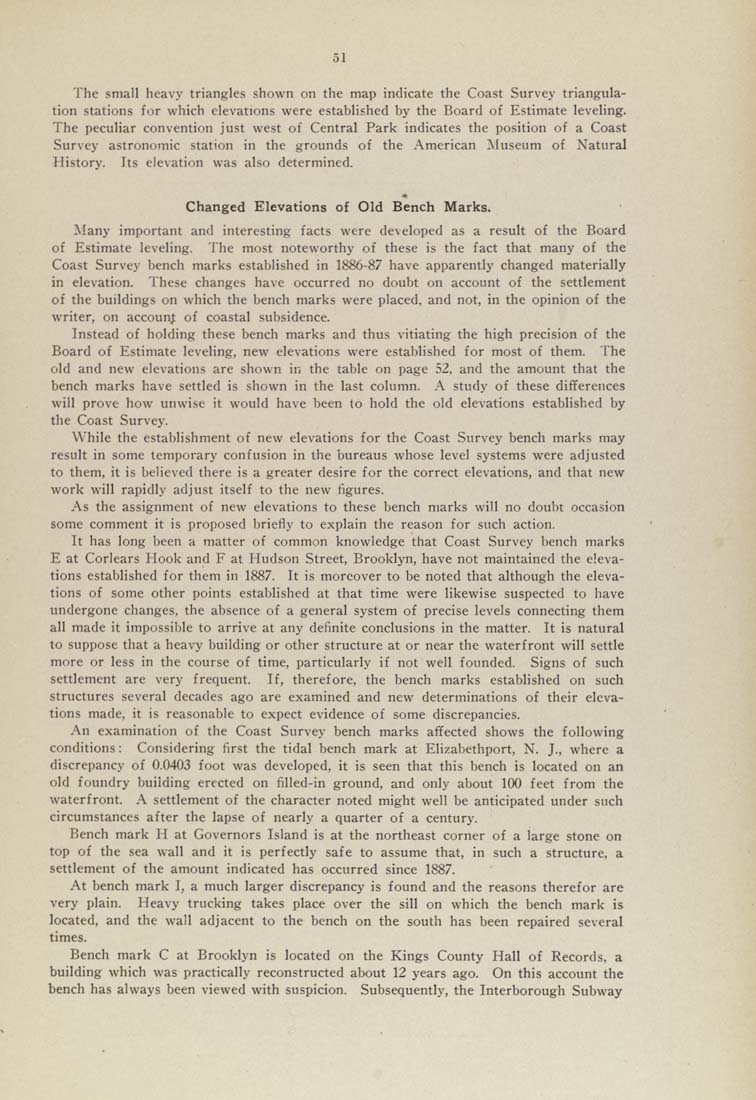.51
The small heavy triangles shown on the map indicate the Coast Survey triangula¬
tion stations for which elevations were established by the Board of Estimate leveling.
The peculiar convention just west of Central Park indicates the position of a Coast
Survey astronomic station in the grounds of the American Museum of Natural
History, Its elevation was also determined.
Changed Elevations of Old Bench Marks.
Many important and interesting facts were de\ eloped as a result of the Board
of Estimate leveling. The most noteworthy of these is the fact that many of the
Coast Survey bench marks established in 1886-87 have apparently changed materially
in elevation. These changes have occurred no doubt on account of the settlement
of the buildings on which the bench marks were placed, and not, in the opinion of the
writer, on accounj: of coastal subsidence.
Instead of holding these bench marks and thus vitiating the high precision of the
Board of Estimate leveling, new elevations were established for most of them. The
old and new elevations are shown in the table on page 52, and the amount that the
bench marks have settled is shown in the last column. A study of these differences
will prove how unwise it would have been to hold the old elevations established by
the Coast Survey.
While the establishment of new elevations for the Coast Survey bench marks may
result in some temporary confusion in the bureaus whose level systems were adjusted
to them, it is believed there is a greater desire for the correct elevations, and that new
work will rapidly adjust itself to the new figures.
As the assignment of new elevations to these bench marks will no doubt occasion
some comment it is proposed briefly to explain the reason for such action.
It has long been a matter of common knowledge that Coast Survey bench marks
E at Corlears Hook and F at Hudson Street, Brooklyn, have not maintained the eleva¬
tions established for them in 1887. It is moreover to be noted that although the eleva¬
tions of some other points established at that time were likewise suspected to have
undergone changes, the absence of a general system of precise levels connecting them
all made it impossible to arrive at any definite conclusions in the matter. It is natural
to suppose that a heavy building or other structure at or near the waterfront will settle
more or less in the course of time, particularly if not well founded. Signs of such
settlement are very frequent. If, therefore, the bench marks established on such
structures several decades ago are examined and new determinations of their eleva¬
tions made, it is reasonable to expect evidence of some discrepancies.
An examination of the Coast Survey bench marks affected shows the following
conditions: Considering first the tidal bench mark at Elizabethport, N. J., where a
discrepancy of 0,0403 foot was developed, it is seen that this bench is located on an
old foundry building erected on filled-in ground, and only about 100 feet from the
waterfront, A settlement of the character noted might well be anticipated under such
circumstances after the lapse of nearly a quarter of a century.
Bench mark H at Governors Island is at the northeast corner of a large stone on
top of the sea wall and it is perfectly safe to assume that, in such a structure, a
settlement of the amount indicated has occurred since 1887.
At bench mark I, a much larger discrepancy is found and the reasons therefor are
very plain. Heavy trucking takes place over the sill on which the bench mark is
located, and the wall adjacent to the bench on the south has been repaired several
times.
Bench mark C at Brooklyn is located on the Kings County Hall of Records, a
building which was practically reconstructed about 12 years ago. On this account the
bench has always been viewed with suspicion. Subsequently, the Interborough Subway
|








